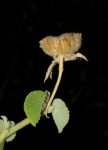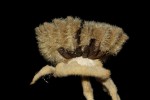Abutilon indicum
guineense
All images: Click on each image to see a larger version and details of the record View selected images
Detailed records: Display species records QDS maps by: Google Maps Point records by Google Maps
Species details: Click on each item to see an explanation of that item (Note: opens a new window)
| Synonyms: |
Abutilon asiaticum sensu Garcke Abutilon guineense (Schumach.) Baker f. & Exell Abutilon hirsutissimum sensu Eyles Sida guineensis Schumach. |
| Common names: | |
| Frequency: | |
| Status: | Native |
| Description: |
Annual or biennial shrubby herb up to c. 1·5 m tall, branching from the base and densely covered with yellowish stellate hairs. Leaves broadly ovate-cordate to suborbicular-cordate, up to 12 cm long, deep yellowish-green above, rough to the touch and thinly stellate-pubescent, paler and softly woolly beneath; margin finely and rather regularly crenate or dentate; petiole about as long as the corresponding lamina. Flowers solitary in the axils of upper leaves of main stems; pedicels up to 8 cm. long, articulated in the upper 11 mm. Calyx 16–19 mm long, lobed to about the middle; lobes triangular or ovate-triangular, often mucronate, usually distinctly mid-veined. Petals obovate, c. 18 mm long, yellow hairless except near the base. Fruit depressed-globose, c. 15 × 20 mm, very densely pilose; mericarps c. 20, their outer apical angle produced into a triangular-acuminate point or somewhat awned, densely pilose to bearded. |
| Type location: |
|
| Notes: | |
| Derivation of specific name: | indicum: of India |
| Habitat: | Grassland and in open places in bush, often on sandy soil. |
| Altitude range: (metres) | Up to 500 m |
| Flowering time: | |
| Worldwide distribution: | From Ghana to Angola, Malawi, Mozambique, Zimbabwe, Eswatini and Mpumalanga, KwaZulu-Natal South Africa. Also in Madagascar. |
| FZ divisions: | Z,TMS,M |
| Growth form(s): | |
| Endemic status: | |
| Red data list status: | |
| Insects associated with this species: | Gomalia elma elma (Larval foodplant) |
| Spot characters: | Display spot characters for this species |
| Images last updated: | Friday 13 October 2017 |
| Literature: |
Exell, A.W. (1961). Malvaceae Flora Zambesiaca 1(2) Page 495. As Abutilon guineense (Includes a picture). Mapaura, A. & Timberlake, J. (eds) (2004). A checklist of Zimbabwean vascular plants Southern African Botanical Diversity Network Report No. 33 Sabonet, Pretoria and Harare Page 60. |
Other sources of information about Abutilon indicum subsp. guineense:
Our websites:
Flora of Malawi: Abutilon indicum subsp. guineenseFlora of Zimbabwe: Abutilon indicum subsp. guineense
External websites:
African Plants: A Photo Guide (Senckenberg): Abutilon indicumAfrican Plant Database: Abutilon indicum
BHL (Biodiversity Heritage Library): Abutilon indicum
EOL (Encyclopedia of Life): Abutilon indicum
GBIF (Global Biodiversity Information Facility): Abutilon indicum
Google: Web - Images - Scholar
iNaturalist: Abutilon indicum
IPNI (International Plant Names Index): Abutilon indicum
JSTOR Plant Science: Abutilon indicum
Mansfeld World Database of Agricultural and Horticultural Crops: Abutilon indicum
Plants of the World Online: Abutilon indicum
Tropicos: Abutilon indicum
Wikipedia: Abutilon indicum


